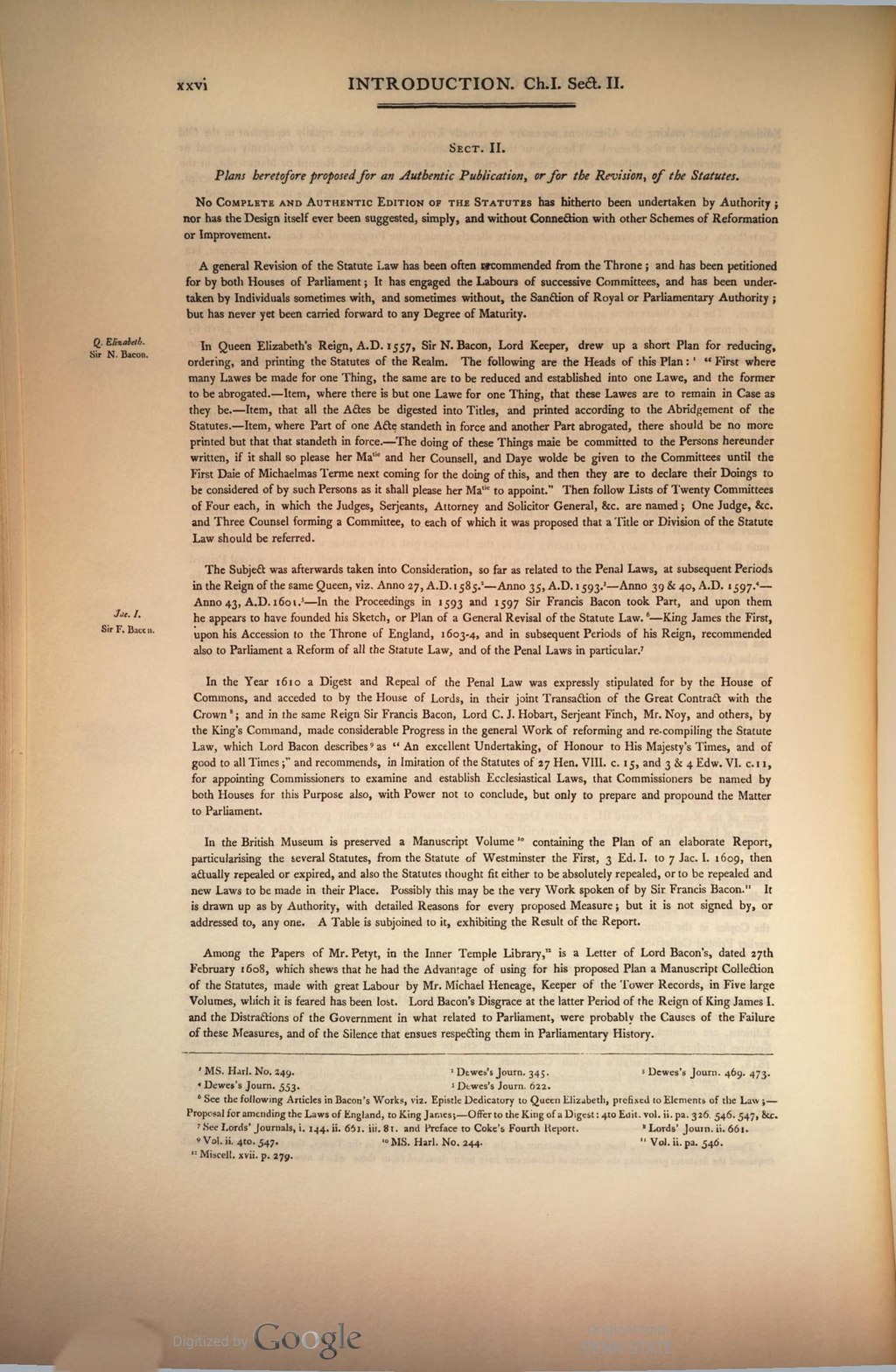Sect. II.
Plans heretofore proposed for an Authentic Publication, or for the Revision, of the Statutes.
No Complete and Authentic Edition of the Statutes has hitherto been undertaken by Authority; nor has the Design itself ever been suggested, simply, and without Connection with other Schemes of Reformation or Improvement.
A general Revision of the Statute Law has been often recommended from the Throne; and has been petitioned for by both Houses of Parliament; It has engaged the Labours of successive Committees, and has been undertaken by Individuals sometimes with, and sometimes without, the Sanction of Royal or Parliamentary Authority; but has never yet been carried forward to any Degree of Maturity.
In Queen Elizabeth’s Reign, A.D. 1557, Sir N. Bacon,Q. Elizabeth. Sir N. Bacon. Lord Keeper, drew up a short Plan for reducing, ordering, and printing the Statutes of the Realm. The following are the Heads of this Plan:[1] “First where many Lawes be made for one Thing, the same are to be reduced and established into one Lawe, and the former to be abrogated.—Item, where there is but one Lawe for one Thing, that these Lawes are to remain in Case as they be.—Item, that all the Actes be digested into Titles, and printed according to the Abridgement of the Statutes.—Item, where Part of one Acte standeth in force and another Part abrogated, there should be no more printed but that that standeth in force.—The doing of these Things maie be committed to the Persons hereunder written, if it shall so please her Matie and her Counsell, and Daye wolde be given to the Committees until the First Daie of Michaelmas Terme next coming for the doing of this, and then they are to declare their Doings to be considered of by such Persons as it shall please her Matie to appoint.” Then follow Lists of Twenty Committees of Four each, in which the Judges, Serjeants, Attorney and Solicitor General, &c. are named; One Judge, &c. and Three Counsel forming a Committee, to each of which it was proposed that a Title or Division of the Statute Law should be referred.
The Subject was afterwards taken into Consideration, so far as related to the Penal Laws, at subsequent Periods in the Reign of the same Queen, viz. Anno 27, A.D.1585.[2]—Anno 35, A.D. 1593.[3]—Anno 39 & 40, A.D. 1597.[4]—Anno 43, A.D. 1601.[5]—In the Proceedings in 1593 and 1597 Sir Francis BaconJac. I. Sir F. Bacon. took Part, and upon them he appears to have founded his Sketch, or Plan of a General Revisal of the Statute Law.[6]—King James the First, upon his Accession to the Throne of England, 1603-4, and in subsequent Periods of his Reign, recommended also to Parliament a Reform of all the Statute Law, and of the Penal Laws in particular.[7]
In the Year 1610 a Digest and Repeal of the Penal Law was expressly stipulated for by the House of Commons, and acceded to by the House of Lords, in their joint Transaction of the Great Contract with the Crown[8]; and in the same Reign Sir Francis Bacon, Lord C. J. Hobart, Serjeant Finch, Mr. Noy, and others, by the King’s Command, made considerable Progress in the general Work of reforming and re-compiling the Statute Law, which Lord Bacon describes[9] as “An excellent Undertaking, of Honour to His Majesty’s Times, and good to all Times;” and recommends, in Imitation of the Statutes of 27 Hen. VIII. c. 15, and 3 & 4 Edw. VI. c. 11, for appointing Commissioners to examine and establish Ecclesiastical Laws, that Commissioners be named by both Houses for this Purpose also, with Power not to conclude, but only to prepare and propound the Matter to Parliament.
In the British Museum is preserved a Manuscript Volume[10] containing the Plan of an elaborate Report, particularising the several Statutes, from the Statute of Westminster the First, 3 Ed. I. to 7 Jac. I. 1609, then actually repealed or expired, and also the Statutes thought fit either to be absolutely repealed, or to be repealed and new Laws to be made in their Place. Possibly this may be the very Work spoken of by Sir Francis Bacon.[11] It is drawn up as by Authority, with detailed Reasons for every proposed Measure; but it is not signed by, or addressed to, any one. A Table is subjoined to it, exhibiting the Result of the Report.
Among the Papers of Mr. Petyt, in the Inner Temple Library,[12] is a Letter of Lord Bacon’s, dated 27th February 1608, which shews that he had the Advantage of using for his proposed Plan a Manuscript Collection of the Statutes, made with great Labour by Mr. Michael Heneage, Keeper of the Tower Records, in Five large Volumes, which it is feared has been lost. Lord Bacon’s Disgrace at the latter Period of the Reign of King James I. and the Distractions of the Government in what related to Parliament, were probably the Causes of the Failure of these Measures, and of the Silence that ensues respecting them in Parliamentary History.
- ↑ MS. Harl. No. 249.
- ↑ Dewes’s Journ. 345.
- ↑ Dewes’s Journ. 469. 473.
- ↑ Dewes’s Journ. 553
- ↑ Dewes’s Journ. 622.
- ↑ See the following Articles in Bacon’s Works, viz. Epistle Dedicatory to Queen Elizabeth, prefixed to Elements of the Law;—Proposal for amending the Laws of England, to King James;—Offer to the King of a Digest: 4to Edit. vol. ii. pa. 326. 546. 547, &c.
- ↑ See Lords’ Journals, i. 144. ii. 651. iii. 81. and Preface to Coke’s Fourth Report.
- ↑ Lords’ Journ. ii. 661.
- ↑ Vol. ii. 4to. 547.
- ↑ MS. Harl. No. 244.
- ↑ Vol. ii. pa. 546.
- ↑ Miscell. xvii. p. 279.
